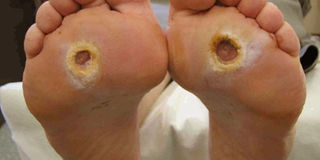Why diabetics need to take care of their feet

This is how a diabetic foot ulcer looks like. Photo | Courtesy
What you need to know:
A study of diabetic patients in TZ showed mortality rates are at 50 per cent among patients with severe foot ulcers, who did not undergo surgery.
Working in the field of medicine, I had the privilege to be supervised by one of the renowned endocrinologists of the country, Dr Kaushik Ramaiya. When you are facing a diagnosis of a hormonal condition, like diabetes or thyroid disease, you may be suggested to see an endocrinologist who specialises in such hormone-related diseases.
Speaking of diabetes, the condition can cause nerve damage and poor blood flow, which can lead to serious foot problems. Working alongside Dr Ramaiya, I got to witness a vast number of diabetic foot complications.
My case
To understand this topic better, I would like to share a case of a 53-year-old man (name withheld for ethical reasons) who is a known case of Type 2 diabetes for the past 8 years and overtime developed foot complications.
When the diabetic came in for diagnosis, he narrated, “It all began with blister which was discharging clear fluid from right foot after I hurt myself unknowingly.”
A few days later, as he further narrated, he experienced severe pain and foul smell from the same leg. His sugar levels were out of control despite of the strict diet and medication, which increased his worry. He then decided to seek medical help. Unfortunately the infection had risen to a great extent above the foot and had spread to the deep tissues that involved the bones. Simply, it was too late.
Upon admission, the diabetic was reviewed by a multidisciplinary team of physicians, vascular and an orthopaedic surgeon. Due to the poor condition of the foot, the solution was to amputate [cut off] the limb. After explaining to him about his condition and thorough counselling, he agreed and underwent above knee amputation which was successful. Currently, this man walks with a prosthetic leg and manages to do his daily activities.
Think for a second, if this patient had noticed the wound earlier, would he be able to save his limb?
The burden
According to the World Journal of Diabetes, diabetic foot ulcer (DFU) is the most costly and devastating complication of diabetes, which affects 15 per cent of diabetic patients during their lifetime, just like the aforementioned case.
It is associated with major morbidity, mortality and reduced quality of life and therefore early detection and prompt effective management is crucial.
Diabetes is the most common non-communicable chronic disease globally. According to World Health Organisation (WHO), the number of people with diabetes has risen from 108 million in 1980 to 422 million in 2014.
It poses a therapeutic challenge to surgeons, especially in developing countries where health care resources are limited and the vast majority of patients report to health facilities late with advanced foot.
What should be done?
Patient education plays a central role. Here’s what needs to be done:
1. Ensure during your monthly follow up at the clinic, instructions are given on foot hygiene.
2. Emphasis is made on daily inspection of your foot.
3. Pressure relieving methods include use of proper footwear which is closed shoes with pressure relieving insoles, clutches and wheelchair ambulation if need be.
4. Look out for new lesions, example fungal lesions of the skin or toe nail and any ingrowth or abnormal nail growth. This should be handled by your doctor.
5. General lifestyle modification - smoking cessation and reducing fatty diet.
6. Last but the most important, have a good control over your glucose level.
Diabetic foot disease is a preventable medical condition. Spread the awareness, save your limb!
The author is a Medical Doctor pursuing post-graduate studies in Paediatrics and Child Health at Muhimbili University of Health and Allied Sciences.




